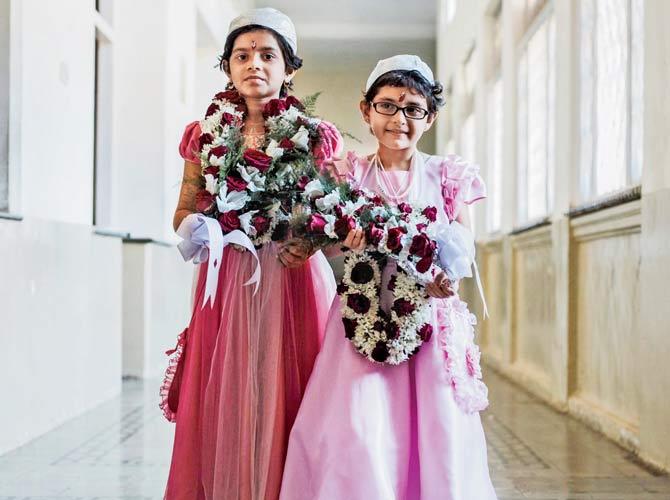Why did a photojournalist from Florence choose to repeatedly return to Mumbai to document a community of 40,000?


After the Navjote ceremony of Sara and Azita. This is like a baptism, when a young Parsi becomes a full Zoroastrian. A long ceremony is performed and the child is given the "Sudreh" and "Kishti" that they are expected to wear every day.
Geographically or otherwise, the Parsis and the Italians could not be more far removed as people. Therefore, it's interesting that Majlend Bramo, a photojournalist based in Florence, made his way to India three years ago with the intention of telling a photo-story on the Zoroastrians of Mumbai. "But, it was meant to be," he tells us over breakfast at the cafeteria inside Kitab Khana on a Thursday morning.

Actor Sohrab Ardeshir as captured by Bramo during evening tea time. The photographer likes the soft sunset light. Pics/Majlend Bramo
Bramo, who was working as a journalist - "in Italy, we don't differentiate between photographer and journalist"- in the Italian newspaper, Corriere dela Sera, had found a spiritual mentor in famous journalist Tiziano Terzani. "I never got the chance to meet him in person; he passed away in 2004, long before I started out. But I learnt a lot about journalism and life in general from the stories he wrote.
He lived most of his life in Asia, including India. He was a deeply spiritual man," Bramo says. In one of his books, Terzani had mentioned Zarathustra, the prophet of the Zoroastrians. The name jumped out at Bramo. "In high school, we had studied Friedrich Nietzsche's Thus Spoke Zarathustra, so the name was familiar, even though that book had nothing to do with the prophet." At that time, Bramo was also looking for a new calling. "Six years into journalism, I realised that I was always telling stories in a rush, without getting a chance to dig deep. I was looking at telling one story at a time and telling it well."
Curious about Zarathustra, when Bramo started his research, he learnt more about the Parsis, their history, and that much of the dwindling community, now resides in Mumbai. "I also realised that Zubin Mehta, who was in Florence at that time, is a Parsi. I had covered his orchestras often as a journalist. It was all adding up for me," Bramo smiles.
When he set off for Mumbai, he was grappling in the dark. He sought to couch-surf to find a place to stay. "I had no idea accommodation was so expensive. I wrote to 20 people on Couchsurfing.com, and guess who replied? A Parsi lady, from Khushroo Baug!" It was through her that he got to other members in the community.
He shot his subjects for over three years, in various environments, from the rudimentary breakfast table to weddings. "In case of families, I would sometimes spend an hour with them in the mornings, and then capture them the second they were not aware of my presence. To capture subjects in their element, I had to step back, not direct them in any way, not even move the tiniest object. It was hard, because as photographers, we are used to shifting things around to create the perfect frame," says the 30-year-old.
This visual documentation has found expression in a book titled, Like Sugar In Milk which releases next month. The book borrows its name from the legendary folklore dating back 1,200 years, about King Jadi Rana of Gujarat being convinced by Persian refugees who had fled Iran after Muslim persecution, to grant them shelter. This he did after the Persians said they'd act like sugar in his kingdom's 'milk' - make the milk sweeter without adding to its volume.
Bramo re-imagines this conversation and has divided the book into five chapters, that interlace the legend with slice-of-life images of how the community lives today. Interestingly, none of the images carry captions. "That was a design choice, really. The captions appear in the end, like an index."
The cover is unlike a photo book too. We are intrigued by a dark, crooked diagonal line on the cover, only to turn the page and discover that is the path which the Persian immigrants followed to reach India. Bramo says he has not authored the book for a Western audience alone. "The Parsis constitute 0.0004 per cent of the Indian population, 40,000 in Mumbai, in a city of 20 million people. I feel most Indians too don't know enough about the community."
What compelled Bramo to pursue the book was the historic parallel he finds between the Parsi chapter in India and Europe's current refugee crisis. "The contribution of Parsis to Mumbai and India is immense. Had Jadi Rana refused them entry into Sanjan, none of this would have existed. I think Europe can take a cue from India. Who knows what the Syrians could make of themselves as immigrants, tomorrow?"
To pre-order a copy, log on to www.majlendbramo.com
Catch up on all the latest Mumbai news, crime news, current affairs, and also a complete guide on Mumbai from food to things to do and events across the city here. Also download the new mid-day Android and iOS apps to get latest updates
 Subscribe today by clicking the link and stay updated with the latest news!" Click here!
Subscribe today by clicking the link and stay updated with the latest news!" Click here!









